-
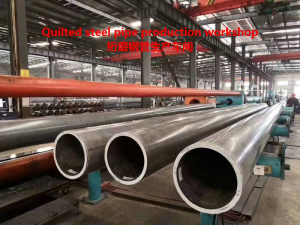
Quilted seamless pipe
Production specification:
Outer diameter of steel pipe 12-377
Steel pipe wall thickness of 2-50
Common material:
10# 0.07~0.13 0.17~0.37 0.35~0.65 ≤0.035 ≤0.035
20# 0.17~0.23 0.17~0.37 0.35~0.65 ≤0.035 ≤0.035
35# 0.32~0.39 0.17~0.37 0.35~0.65 ≤0.035 ≤0.035
45# 0.42~0.50 0.17~0.37 0.50~0.80 ≤0.035 ≤0.035
40cr 0.37~0.44 0.17~0.37 0.50~0.80 ≤0.035 ≤0.035 0.08~1.10
25Mn 0.22~0.2 0.17~0.37 0.70~1.00 ≤0.035 ≤0.035 ≤0.25
37Mn5 0.30~0.39 0.15~0.30 1.20~1.50 ≤0.015 ≤0.020
Introduction:
Quilted seamless pipe is a kind of high precision steel pipe material after cold drawing or hot rolling. Because there is no oxide layer on the inner and outer walls of precision steel pipe, [1] under high pressure without leakage, high precision, high finish, cold bending without deformation, flaring, flattening without cracks and so on, it is mainly used for the production of pneumatic or hydraulic components, such as cylinders or cylinders, which can be seamless. The chemical composition of quilted seamless tube is carbon C, silicon Si, manganese Mn, sulfur S, phosphorus P, chromium Cr
Quilted seamless pipe adopts processing technology
The quilted seamless pipe is processed by rolling. Because of the residual compressive stress on the surface layer, it is helpful to close the micro cracks on the surface and prevent the expansion of erosion. It can improve the surface corrosion resistance and delay the generation or expansion of fatigue cracks, so as to improve the fatigue strength of quilted steel pipe. By rolling forming, a cold working hardening layer is formed on the rolling surface, which reduces the elastic and plastic deformation of the contact surface of the grinding pair, thus improving the wear resistance of the inner wall of the quilted steel pipe and avoiding the burn caused by grinding. After rolling, the reduction of surface roughness can improve the fit property.
Rolling machining is a kind of chip free machining. At normal temperature, the plastic deformation of metal is used to flatten the microscopic roughness of the workpiece surface so as to achieve the purpose of changing the surface structure, mechanical characteristics, shape and size. Therefore, this method can achieve the two purposes of polishing and strengthening at the same time, which is unable to do grinding.
No matter what kind of processing method is used to process, there will always be fine convex and concave uneven knife marks on the surface of the parts, and the phenomenon of staggered peaks and valleys,
Rolling processing principle: It is a kind of pressure finishing processing, is the use of metal in the normal temperature state of cold plastic characteristics, the use of rolling tools to exert a certain pressure on the workpiece surface, so that the workpiece surface metal plastic flow, fill into the original residual low concave trough, and achieve the workpiece surface roughness value reduced. Due to the plastic deformation of the rolled surface metal, the surface tissue cold hardening and grain thinning, the formation of dense fiber, and the formation of residual stress layer, hardness and strength, thus improving the wear resistance, corrosion resistance and compatibility of the workpiece surface. Rolling is a plastic machining method without cutting.
Quilted seamless pipe several advantages:
1, improve the surface roughness, roughness can basically reach Ra≤0.08µ m or so.
2, correct roundness, ellipticity can be less than 0.01mm.
3, improve the surface hardness, the force deformation is eliminated, hardness increase HV≥4°
4, after processing residual stress layer, improve the fatigue strength by 30%.
5, improve the quality of fit, reduce wear, prolong the service life of parts, but the processing cost of parts is reduced.
-
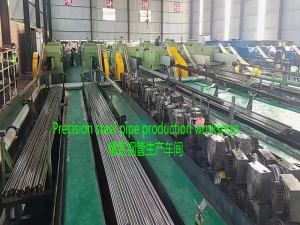
Precision steel pipe
Product introduction:
Precision steel pipe high size, high precision, pipe inside and outside surface finish, after heat treatment of steel pipe inside and outside the surface are no oxide film, steel pipe flaring, flattening without cracks, cold bending without deformation, and can withstand high pressure, can make a variety of complex deformation and mechanical deep processing.
The main production of steel pipe brands: 10#, 20#, 35#, 45#, 40cr, 42crmo, 16mn, etc
Production specification:
Outer diameter of steel pipe 12-159
Steel pipe wall thickness of 2-30
Basic use:
Precision steel pipe is widely used in automobiles, motorcycles, electric vehicles, petrochemical, electric power, ships, aerospace, bearings, pneumatic components, medium and low pressure boiler seamless steel pipe and other fields, can also be applied to steel bar sleeve, bearings, hydraulic, mechanical processing and other fields!
Production process:
The production process of precision steel pipe is the same as that of ordinary seamless pipe, that is, there is a final pickling and cold rolling procedure.
Precision steel pipe process flow
Tube billet heating – inspection – skin – - – perforation, pickling passivation, grinding – oil lubrication dry – cold rolled – to – cut head – inspection, identification, finished product packaging
-
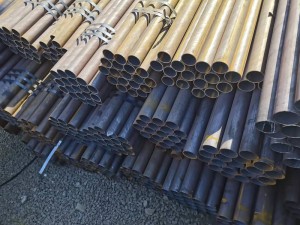
10# Seamless steel pipe
Production specification:
Outer diameter of steel pipe 20-426
Steel pipe wall thickness of 20-426
Chemical composition:
● No. 10 seamless steel pipe chemical composition:
Carbon C: 0.07~0.14″ silicon Si: 0.17 ~ 0.37 Manganese Mn: 0.35 ~ 0.65 Sulfur S: ≤0.04 Phosphorus P: ≤0.35 chromium Cr: ≤0.15 Nickel Ni: ≤0.25 Copper Cu: ≤0.25
Mechanical property:
Mechanical properties of No. 10 seamless steel pipe:Tensile strength σb (MPa) : ≥410(42) Yield strength σs (MPa) : ≥245(25) elongation δ5 (%) : ≥25 sectional shrinkage (%) : ≥5, hardness: unheated,≤156HB, sample size: 25mm.
High quality carbon structural steel:
No. 10 seamless steel pipe does not contain other alloy elements (except residual elements) except carbon (C) element and a certain amount of silicon (Si) for deoxidation (generally not more than 0.40%), manganese (Mn) (generally not more than 0.80%, up to 1.20%) alloy elements.
Such steel must have both chemical composition and mechanical properties. The contents of sulfur (S) and phosphorus (P) are generally controlled below 0.035%. If it is controlled below 0.030%, it is called high quality steel, and “A” should be added after the grade, such as 20A; If P is controlled below 0.025% and S is controlled below 0.020%, it is called extra high quality steel, and “E” should be added after the grade to show the difference. For other residual alloying elements brought into steel by raw materials, such as chromium (Cr), nickel (Ni), copper (Cu), etc., the content of Cr≤0.25%, Ni≤0.30%, Cu≤0.25%. Some brands of manganese (Mn) content up to 1.40%, known as manganese steel.
No. 10 seamless steel pipe weight calculation formula :[(outer diameter - wall thickness)* wall thickness]*0.02466=kg/ m (weight per meter)
-
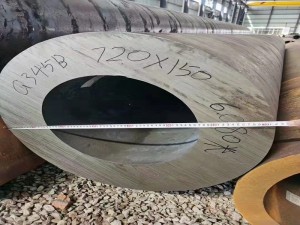
Q345B Seamless tube
Production specification:
Outer diameter of steel pipe 20-426
Steel pipe wall thickness of 20-426
Main characteristics:
Good comprehensive mechanical properties, weldability, cold, hot working properties and corrosion resistance, with good low temperature toughness
Product application:
Ships, boilers, pressure vessels, oil storage tanks, Bridges, power plant equipment, lifting machinery and other welding structures with higher loads
-
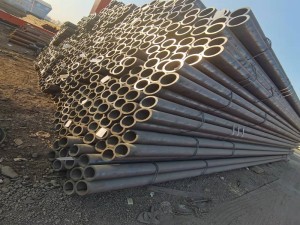
35CrMo alloy steel pipe
Production specification:
Outer diameter of steel pipe 20-426
Steel pipe wall thickness of 20-426
Product introduction:
For example, 40Cr. (Carbon content of 35CrMo alloy steel pipe is 0.32~0.40, silicon 0.17~0.37, manganese 0.40~0.70, molybdenum 0.15~0.25, chromium 0.80~1.10)
② The main alloying elements in steel, except some microalloying elements, are generally expressed by several percent. When the average alloy content is less than 1.5%, only the element symbol is generally marked in the steel number, but not the content. However, in special cases, it is easy to confuse, the number “1″ can be marked after the element symbol, such as the steel number “12CrMoV” and “12Cr1MoV”, the chromium content of the former is 0.4-0.6%, and that of the latter is 0.9-1.2%. Everything else is the same. When the average alloying element content ≥1.5%, ≥2.5%, ≥3.5%…… “, the element symbol should be marked after the content, can be expressed as 2, 3, 4…… Etc. For example, 18Cr2Ni4WA.
③ Alloy elements such as vanadium V, titanium Ti, aluminum AL, boron B and rare earth RE in steel belong to microalloying elements. Although the content is very low, they should still be marked on the steel number. For example, in 20MnVB steel. Vanadium is 0.07-0.12% and boron is 0.001-0.005%.
④ “A” should be added at the end of the steel number of high-grade steel to distinguish it from general high-quality steel.
⑤ Special purpose alloy structural steel, steel number prefix (or suffix) represents the purpose of the steel symbol. For example, the 30CrMnSi steel specially used for riveting screws is expressed as ML30CrMnSi.
Alloy tube and seamless tube both have relations and differences, can not be confused.
Alloy pipe is steel pipe in accordance with the production material (that is, material) to define, as the name suggests is made of alloy pipe; And seamless pipe is steel pipe in accordance with the production process (seamless) to define, different from seamless pipe is welded pipe, including straight seam welded pipe and spiral pipe.
Manufacturing technology:
1. Hot rolling (extrusion seamless steel pipe) : round tube blank → heating → perforating → three-high diagonal rolling, continuous rolling or extrusion → stripping → sizing (or reducing) → cooling → straightening → hydrostatic test (or inspection) → marking → storage
2. Cold-drawn (rolled) seamless steel pipe: round tube blank → heating → perforation → heading → annealing → pickling → oiling (copper plating) → multi-pass cold drawing (cold rolling) → blank tube → heat treatment → straightening → hydrostatic test (inspection) → marking → storage
-
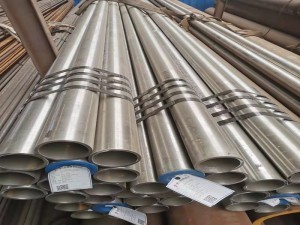
30CrMo alloy steel pipe
Production specification:
Outer diameter of steel pipe 20-426
Steel pipe wall thickness of 20-426
Product introduction:
① The two digits at the beginning of the steel number indicate the carbon content of the steel, with the average carbon content of a few thousand, such as 40Cr, 30CrMo alloy steel pipe
② The main alloying elements in steel, except some microalloying elements, are generally expressed by several percent. When the average alloy content is less than 1.5%, only the element symbol is generally marked in the steel number, but not the content. However, in special cases, it is easy to confuse, the number “1″ can be marked after the element symbol, such as the steel number “12CrMoV” and “12Cr1MoV”, the chromium content of the former is 0.4-0.6%, and that of the latter is 0.9-1.2%. Everything else is the same. When the average alloying element content ≥1.5%, ≥2.5%, ≥3.5%…… “, the element symbol should be marked after the content, can be expressed as 2, 3, 4…… Etc. For example, 18Cr2Ni4WA.
③ Alloy elements such as vanadium V, titanium Ti, aluminum AL, boron B and rare earth RE in steel belong to microalloying elements. Although the content is very low, they should still be marked on the steel number. For example, in 20MnVB steel. Vanadium is 0.07-0.12% and boron is 0.001-0.005%.
④ “A” should be added at the end of the steel number of high-grade steel to distinguish it from general high-quality steel.
⑤ Special purpose alloy structural steel, steel number prefix (or suffix) represents the purpose of the steel symbol. For example, the 30CrMnSi steel specially used for riveting screws is expressed as ML30CrMnSi.
Manufacturing technology:
1. Hot rolling (extrusion seamless steel pipe) : round tube blank → heating → perforating → three-high diagonal rolling, continuous rolling or extrusion → stripping → sizing (or reducing) → cooling → straightening → hydrostatic test (or inspection) → marking → storage
2. Cold-drawn (rolled) seamless steel pipe: round tube blank → heating → perforation → heading → annealing → pickling → oiling (copper plating) → multi-pass cold drawing (cold rolling) → blank tube → heat treatment → straightening → hydrostatic test (inspection) → marking → storage
-
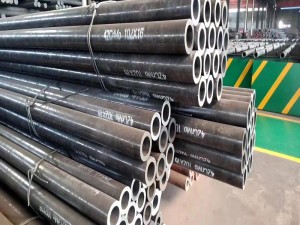
42crmo Seamless steel pipe
Production specification:
Outer diameter of steel pipe 20-426
Steel pipe wall thickness of 20-426
Product introduction:
The purpose of 42crmo seamless steel pipe: the special steel for bridge is “42crmo”, the special steel for automobile girder is “42CRmo”, the special steel for pressure vessel is “42Crmo”. This kind of steel is to rely on the adjustment of carbon (C) content to improve the mechanical properties of steel, therefore, according to the carbon content of high and low, this kind of steel can be divided into: low carbon steel – carbon content is generally less than 0.25%, such as 10, 20 steel, etc.; Medium carbon steel – carbon content is generally between 0.25 ~ 0.60%, such as 35, 45 steel, etc. High carbon steel – carbon content generally greater than 0.60%. Such steel is not normally used to make steel pipes.
Process specification:
Hot working specification
Heating temperature 1150 ~1200°C, starting temperature 1130 ~1180°C, end temperature > 850°C,φ> 50mm, slow cooling.
Normalizing specification
Normalizing temperature 850~900°C, out of the oven air cold.
High temperature tempering specification
Tempering temperature 680~700°C, out of the oven air cold.
Specification for quenching and tempering
Preheating temperature 680 ~700°C, quenching temperature 840~880°C, oil cooling, tempering temperature 580°C, water cooling or oil cooling, hardness ≤217HBW.
Specification for hardening and toughening under – temperature quenching
Quenching temperature 900°C, tempering temperature 560°C, hardness (37±1) HRC
Specification for induction hardening and tempering
Quenching temperature 900°C, tempering temperature 150~180°C, hardness 54 ~60HRC.
-

45# Seamless Steel pipe
Production specification:
Outer diameter of steel pipe 20-426
Steel pipe wall thickness of 20-426
Product introduction:
The raw material of rolling seamless tube is round tube billet, round tube embryo is cut and processed by cutting machine with the growth of about 1 meter blank, and sent to the furnace by conveyor belt heating. The billet is fed into a furnace and heated to about 1200 degrees Celsius. The fuel is hydrogen or acetylene. The temperature control in the furnace is the key problem. After the round tube billet comes out, it is perforated by the pressure punch. Generally, the most common perforator is the conical roll perforator. This kind of perforator has high production efficiency, good product quality, large perforating diameter and can wear a variety of steel. After perforation, the round tube billet is successively rolled by three high diagonal, continuous rolling or extrusion. After extrusion, the pipe should be removed for sizing. The caliper rotates into the steel embryo through a conical drill at high speed to punch holes and form steel pipes. The inner diameter of the steel pipe is determined by the outer diameter length of the caliper drill bit. After sizing the steel pipe, it enters the cooling tower and is cooled by spraying water. After cooling the steel pipe, it will be straightened. After straightening, the steel pipe is sent by conveyor belt to the metal inspection machine (or hydraulic test) for internal inspection. If there are cracks, bubbles and other problems inside the steel pipe, it will be detected. Steel pipe quality inspection after the strict hand selection. After the steel pipe is inspected, the number, specification and production lot number are sprayed with paint. And by the crane into the warehouse.
-
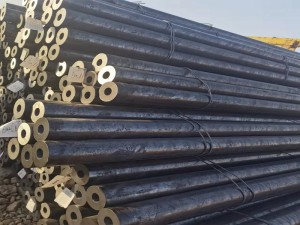
40cr seamless steel pipe
Production specification:
Outer diameter of steel pipe 20-426
Steel pipe wall thickness of 20-426
Steel pipe standard:
According to standard GB/T 3077-2008: chemical composition (mass fraction, %) C 0.37~0.44, Si 0.17~0.37, Mn 0.50~0.80, Cr0.80~1.10, Ni≤0.30. 【 Mechanical properties 】
Sample blank size (mm) : 25
Heat treatment:
First quenching heating temperature (℃) : 850; Coolant: Oil
Second quenching heating temperature (℃) : -
Tempering heating temperature (℃) : 520; Coolant: water, oil
Tensile strength (σb/MPa) : ≧980
Yield point (σs/MPa) : ≧785
Elongation after breaking (δ5/%) : ≧9
Reduction rate of cross-section (ψ/%) : ≧45
Impact absorption work (Aku2/J) : ≧47
Brinell hardness (HBS100/3000) (annealing or high-temperature tempering condition) : ≦207
-
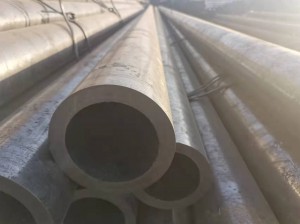
20# Seamless steel pipe
Production specification:
Outer diameter of steel pipe 20-426
Steel pipe wall thickness of 20-426
20# seamless steel pipe is made of 20# steel, with slightly higher strength than 15#, rarely quenched and no tempering brittleness. Cold deformation plasticity is high, generally for bending, calendering, bending and hammer arch processing, welding performance of arc welding and contact welding is good, gas welding thickness is small, the shape of strict requirements or complex shape of the workpiece is easy to crack. Machinability cold drawing or normalizing state is better than annealing state, generally used to manufacture less stress and high toughness requirements of the workpiece.
The material of 20# seamless steel pipe is: high quality carbon structural steel
Brand number: 20#
Standard: GB8162-2018
GB/T8163-2018
GB3087-2008
GB9948-2013
GB5310-2017
-

3087 low pressure boiler tube
Seamless steel pipe is a kind of round, square and rectangular steel with hollow section and no joints around Seamless steel pipe is made of steel ingot or solid tube blank through perforation, and then hot rolled, cold rolled or cold drawn Seamless steel pipe has a central control section and is widely used as a pipeline for conveying fluid. Compared with solid steel such as round steel, the steel pipe has the same bending and torsional strength and is lighter. It is an economic section steel. It is widely used in the manufacture of structural parts and mechanical parts, such as oil drill pipe, automobile transmission shaft, bicycle frame and steel pipe used in construction
-
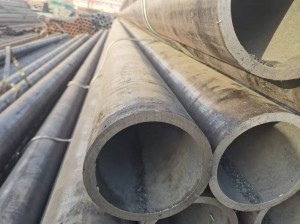
Large diameter thick wall seamless alloy steel pipe
Seamless steel pipe is a kind of round, square and rectangular steel with hollow section and no joints around Seamless steel pipe is made of steel ingot or solid tube blank through perforation, and then hot rolled, cold rolled or cold drawn Seamless steel pipe has a central control section and is widely used as a pipeline for conveying fluid. Compared with solid steel such as round steel, the steel pipe has the same bending and torsional strength and is lighter. It is an economic section steel. It is widely used in the manufacture of structural parts and mechanical parts, such as oil drill pipe, automobile transmission shaft, bicycle frame and steel pipe used in construction